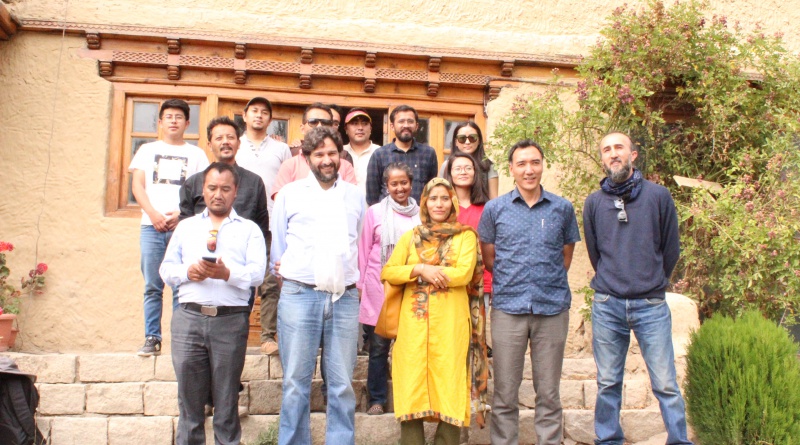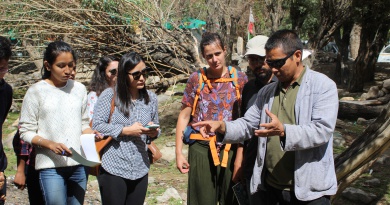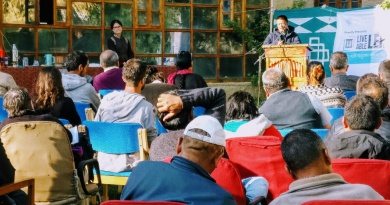Third meeting of Strategic Planning Committee with Tikender Panwar
Activity: Third meeting of the Strategic Planning Committee Date: August 21, 2018 Location: LEDeG Office Meeting Hall, Karzoo Participants: 7
Expert: Tikender Panwar, former deputy mayor of Shimla
- Objective: Keeping the Master Plan of Shimla in mind, the Strategic Planning Committee through Tikender Panwar aims to formulate a plan to eventually create a Vision Document and a Master Plan for Leh town
- Summary Agenda:
Time Activity PiC Remarks 10:00AM Welcome speech Tenzin Motup 10:10AM Expert Talk Tikender Panwar 11:10 AM Tea Break 11:30 AM Expert Talk Tikender Panwar 1:30 PM Lunch Break 2:00 PM Expert Talk and Question and Answer Session Tikender Panwar 2:30 PM Vote of thanks Tenzin Motup
- Summary of Results:
Vision Document:
The goal is to eventually create a Vision Document. The primary objective is to create a Master Plan and through it create a Vision Document. But in case of Leh, we are first looking at creating a Vision Document and through it reach at the Master Plan.
When the plan is shared with the locals and they give the final nod then it becomes statutory
Today, there are more than 50,000 residents in Leh and more than 10,000 army personnels. Therefore, Leh urgently needs urban planning because there are lots of stokeholders, workers, consumers, etc.
There are different forms of planning. I am not in favour of spontaneous planning. I like following the basics of planning.
Currently, Leh is in a state of transformation, but will it help or ruin Leh is the big questions. There are certain tools and priorities which is important in inception of planning, but we must move beyond those priorities. E.g., Communities in Shimla were pastorals were at the time of British Rule. Britishers moved to hilly areas to escape from the heat. They also brought infrastructure planning along with them. They had the technology to lift water up to a height of 2,000 metres. Shimla is now entirely dependent on surface water, whereas people of Leh use 80% groundwater.
Requirement for a Vision which is collective, which evolves with what is happening around and that which brings wisdom. Vision should not remain a vision. But no vision is statutory and implementable. It has to evolve through people and flexibility is needed.
The process for Vision Document should not only be top-bottom but also bottom-top.
The first layer of the Vision Document should be indigenous. Find what our strength is and then build layer on it.
The Vision should be that we must become self-sustainable. Army, which is also a major stakeholder in Leh, should be on the panel of the committee
Tourism:
The in-flow of tourists brings benefits as well as challenges. How to control and regulate tourism?
Romi Khosla and Prabhat Patnaik conducted a socio-economic study in Leh on the behest of Farooq Abdullah in the 1980’s.
Romi Khosla has come up with a set of rules, which is called the Operation Manual. That Manual is very import for the inception of the Vision Document for Leh town. Tikender to get the report and share it with Strategic Planning Committee.
There should be data and study on tourism in Leh. A policy should be formulated for Leh town. The tourism should be sustainable, but we should not put restrictions. Sustainable tourism is the one in which money stays in the town
We have to see how the person pays for what he pollutes.
How can we regulate/check Make My Trip, Yatra travellers in Leh? We have to ensure the money generated through tourists come back to the city.
Leh is at a historical conjuncture. So, whatever we action we take today, we will reap the benefits 30 years down the line.
Cities evolve due to socio-economic dynamics in the society. Rise in income takes you to a gated society.
We must focus on water requirement, solid waste management and disaster management if tourism increases in the next few years.
How the city should look like?
Sustainable Development Goals have a meaning. Eg, Paris and New York. Paris was built at the behest of Napolean. Haussmann renovated the city. He was followed by Moses. They built cities keeping the high-end of the society in mind. But what about the vulnerable communities?
Le Corbusier model is something we wish we could replicate. Chandigarh was created keeping the poor in mind. The houses were built without the use of steel, no second storey, walls with no plaster. That Vision was possible because Corbusier had the backing of Jawaharlal Nehru.
Urban Mobility:
Don’t allow vehicles in certain areas. Follow the example of Shimla. Start levying Green Fee. The pedestrian roads should be nice to walk on.
Although, Leh town has a radius share of 6km, the average distance covered by pedestrians is just 2km. The percentage of pedestrians is 26%, which, in fact, should have been 80%. In Shimla, 45% are pedestrians, 9% use private vehicles and the rest travel in public transport. Cases such as diabetes, which were never heard of in mountain states, have become common today.
Create walking spaces. Don’t concrete the paths. Disadvantages of concrete: 1) Enhances flooding, 2) It withers away. Drains should not be concrete. Create pathways with indigenous technology. Don’t use materials made in tropical conditions in temperate conditions.
Encourage plying electric mobility buses instead of diesel ones. The taxi drivers could use electric/solar cars.
Change category of roads. Make roads which are strong. Don’t widen the road, slowly work on pedestrianization. The streets should not be occupied and it must be lighted. Give space to hawkers in a separate area.
Enforce no-parking zones and also create space for parking. The roads should be narrow and the footpaths wide.
Resources:
There is liquidity in the city but where is it going? Why is investment not taking place? Therefore, get an economic expert on the panel.
Encourage horticulture, agriculture in Leh. Promote Yak cheese, milk and butter.
Come up with plans to sustain agriculture and horticulture. Get someone from agriculture on the board.
Build a food processing plant in Leh, so that we are not overly reliant on food from outside. Become self-sufficient.
The Vision Document has to include livestock and agriculture, and the methods to conserve it.
Diversification is needed and tourism has to be sustainable.
We should not only look at land-use but also infrastructure building. We have to look what is implementable immediately and do it. Whatever wealth is drawn from tourists should be returned to the city. Levy fee on tourists entering Leh and use that money for development works.
The governance and its structure should be debated. There should be city governance. The only thing universally handled by the government is garbage. The permissible solid waste had increased from 120gm per capita to 440 gm per capita. It is a serious challenge but we have not been able to manage it. City government is the one to mitigate the challenges. E.g., Project Montreal and Let’s win back Barcelona!
Make agriculture remunerative, so that we could sustain it.
We must target revenue so that we could strengthen the financial capabilities of the government.
Why promote Amul milk and not yak milk? Why can’t we have our own bakery? We must put some tax on incoming packaged products in Leh. We must increase self-sufficiency.
How to empower the local bodies?
The city should have mayor with Councillors.
Subjects such as road, water, sanitation, should be transferred to him. Financial power should also be transferred to him, like he should have say in environmental fee charged to the tourists. He should have the authority on what to do with the money for the betterment of the city
Who should govern the city?
One single agency should run the water department. In case of Shimla, the government shared the responsibility with the municipality. Water is tested in Shimla everyday and the data is then thrown for the people on the municipality’s website. Now people can drink from taps.
Create a system where tap water could be made potable. Reinvent the system.
Problems:
If we don’t take preventive actions right now, then someone else will- in this case the Court who could direct National Green Tribunal to intervene. Eg, Rohtang Pass. NGT intervened due to nonregulation of tourists visiting the Pass. The situation will precipitate if we don’t take action and the precipitation will happen soon.
Shimla has 7-8 plans and is flooded with data. But the impediment in Leh is the lack of data.
The by-laws by the Britishers were far better than ours
Suggestions:
Keep aesthetics in mind and don’t obstruct the valley view in mountains.
Get rid of poplar trees. Find trees which could be planted in water catchment areas.
Green Growth Strategy should be one of the main targets.
We should go for 100% renewable energy, such as wind, solar, electric.
Manual on the lines of Democracy Owner’s Manual should be there for the conservation of water. There should be a city operation manual, in which the ownership is by the people and not the bureaucrats.


